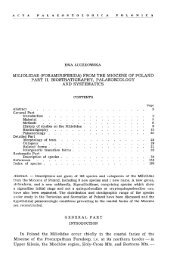The skull of Velociraptor - Acta Palaeontologica Polonica
The skull of Velociraptor - Acta Palaeontologica Polonica
The skull of Velociraptor - Acta Palaeontologica Polonica
Create successful ePaper yourself
Turn your PDF publications into a flip-book with our unique Google optimized e-Paper software.
190 Skull <strong>of</strong> <strong>Velociraptor</strong>: BARSBOLD & OSMOLSKA<br />
Kirkland, Burge, & Gaston, 1993, and <strong>Velociraptor</strong> Osborn, 1924 are presently as-<br />
signed to this family. Three <strong>of</strong> these genera (Adasaurus, Hulsanpes, and Ornitho-<br />
desmus), are based exclusively on incomplete postcrania.<br />
<strong>The</strong> most peculiar dromaeosaurid feature is the opisthopubic pelvis (Barsbold<br />
1976), which distinguishes these dinosaurs from other theropods, except for the dis-<br />
tantly related therizinosauroids; the extremely long caudal zygapophyses and chev-<br />
rons are probably also common to all dromaeosaurids, but caudal vertebrae are known<br />
only in Deinonychus, <strong>Velociraptor</strong>, and Saurornitholestes (Dr P.J. Currie's personal<br />
communication 1999)<br />
<strong>The</strong> <strong>skull</strong> <strong>of</strong> V mongoliensis has been known for more than 70 years. Over this time,<br />
it has been described, illustrated or commented by several authors, among them Sues<br />
(1977a), Barsbold (1983), Paul (1988), and Ostrom (1969b, 1990). Up to now, Veloci-<br />
raptor is represented by the most complete and most numerous <strong>skull</strong>s and postcrania<br />
among dromaeosaurids (in addition to the here described material, there are numerous<br />
still not described specimens recently collected by the AMNH Asiatic Expeditions).<br />
It was Ostrom (1969a), who first recognised the close relationship <strong>of</strong> <strong>Velociraptor</strong><br />
with the North American forms, Dromaeosaurus and Deinonychus, and assigned it to<br />
the Dromaeosauridae (= Dromaeosaurinae Matthew & Brown 1922). <strong>The</strong> <strong>skull</strong>s are<br />
largely complete in the two latter genera, whereas <strong>skull</strong>s <strong>of</strong> Saurornitholestes and<br />
Utahraptor are represented by a few bones each. <strong>The</strong> following description <strong>of</strong> the <strong>skull</strong><br />
in V mongoliensis supplements the earlier descriptions by Osborn (1924), Sues<br />
(1977a), and Barsbold (1983). <strong>The</strong> <strong>skull</strong> data for D. antirrhopus, Dromaeosaurus<br />
albertensis, and Saurornitholestes langstoni used in the comparisons below are re-<br />
spectively from Ostrom (1969b), Colbert & Russell (1969), Currie (1995), Sues<br />
(1977a), and Witmer & Maxwell (1996), unless stated otherwise.<br />
Institutional abbreviations: AMNH, American Museum <strong>of</strong> Natural History, New<br />
York; GIN, Institute <strong>of</strong> Geology, Mongolian Academy <strong>of</strong> Sciences, Ulan Bator;<br />
PIN, Museum <strong>of</strong> Palaeontology, Russian Academy <strong>of</strong> Sciences, Moscow; ROM,<br />
Royal Ontario Museum, Toronto; TPM, Royal Tyrrell Museum <strong>of</strong> Palaeontology,<br />
Drumheller; ZPAL, Institute <strong>of</strong> Paleobiology, Polish Academy <strong>of</strong> Sciences, Warsaw.<br />
Systematic palaeontology<br />
<strong>The</strong>ropoda Marsh, 1881<br />
Maniraptora Gauthier, 1986<br />
Family Dromaeosauridae Matthew & Brown, 1922<br />
Subfamily <strong>Velociraptor</strong>inae Barsbold, 1983<br />
<strong>Velociraptor</strong> Osborn, 1924<br />
Type species by monotypy: <strong>Velociraptor</strong> mongoliensis Osborn, 1924.<br />
<strong>Velociraptor</strong> mongoliensis Osborn, 1924<br />
Figs 1-8.<br />
Holotype: AMNH 6515, <strong>skull</strong>, mandible, manual digit I.

















